YoloV6实战:手把手教你使用Yolov6进行物体检测(附数据集)
摘要
YOLOv6 主要在 BackBone、Neck、Head 以及训练策略等方面进行了诸多的改进:
- 统一设计了更高效的 Backbone 和 Neck :受到硬件感知神经网络设计思想的启发,基于 RepVGG style[4] 设计了可重参数化、更高效的骨干网络 EfficientRep Backbone 和 Rep-PAN Neck。
- 优化设计了更简洁有效的 Efficient Decoupled Head,在维持精度的同时,进一步降低了一般解耦头带来的额外延时开销。
- 在训练策略上,采用Anchor-free 无锚范式,同时辅以 SimOTA[2] 标签分配策略以及 SIoU[9] 边界框回归损失来进一步提高检测精度。
在 COCO 数据集上,YOLOv6 在精度和速度方面均超越YOLOv5、YOLOX和 PP-YOLOE等这样比较有代表性的算法,相关结果如下图 所示:
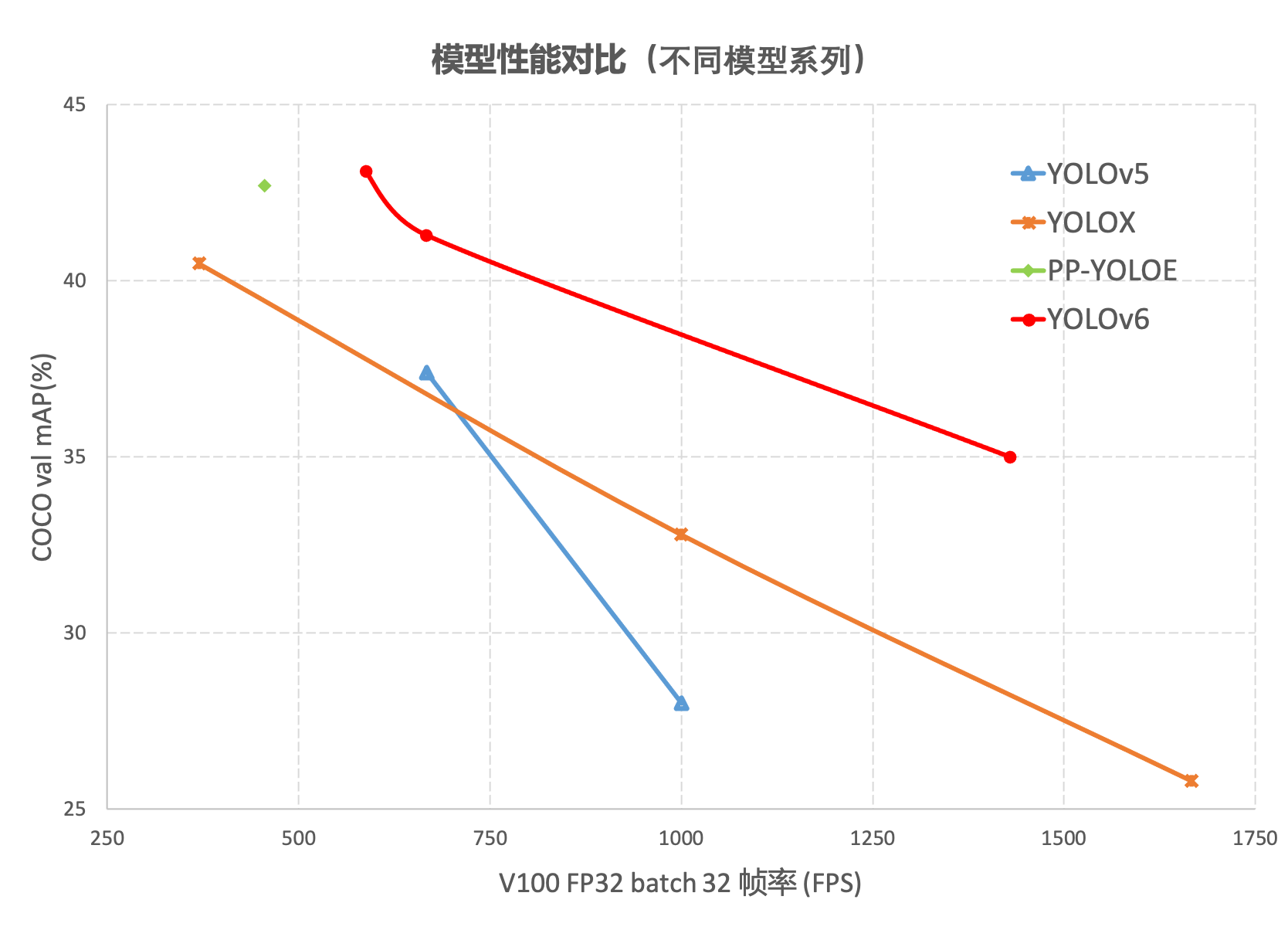

这篇文章没有论文,只有美团的一篇论文介绍和github的代码,链接如下:
github地址:https://github.com/meituan/YOLOv6
详见:
https://tech.meituan.com/2022/06/23/yolov6-a-fast-and-accurate-target-detection-framework-is-opening-source.html
今天这篇文章主要演示如何跑通代码。
数据集
数据集是Labelme标注的数据集,下载地址:
https://download.csdn.net/download/hhhhhhhhhhwwwwwwwwww/14003627
数据集是我为了调物体检测模型制作的,数据集有两个类别,分别是:aircraft,oiltank。
如果有人想做别的尝试,也可以选用我制作的另一个数据集,也是Labelme标注的格式,链接如下:
https://download.csdn.net/download/hhhhhhhhhhwwwwwwwwww/63242994。
总共32种飞机:
[‘c17’, ‘c5’, ‘helicopter’, ‘c130’, ‘f16’, ‘b2’, ‘other’, ‘b52’, ‘kc10’, ‘command’, ‘f15’, ‘kc135’, ‘a10’, ‘b1’, ‘aew’, ‘f22’, ‘p3’, ‘p8’, ‘f35’, ‘f18’, ‘v22’, ‘f4’, ‘globalhawk’, ‘u2’, ‘su-27’, ‘il-38’, ‘tu-134’, ‘su-33’, ‘an-70’, ‘su-24’, ‘tu-22’, ‘il-76’]
接下来是如何制作yolov6数据集,yolov6使用的数据集格式和yolov5一样。如图:

格式:类别,中心点x,中心点y,w,h。
新建脚本make_yolo_data.py,插入代码:
import os
import shutil
import numpy as np
import json
from glob import glob
import cv2
from sklearn.model_selection import train_test_split
from os import getcwd
def convert(size, box):
dw = 1. / (size[0])
dh = 1. / (size[1])
x = (box[0] + box[1]) / 2.0 - 1
y = (box[2] + box[3]) / 2.0 - 1
w = box[1] - box[0]
h = box[3] - box[2]
x = x * dw
w = w * dw
y = y * dh
h = h * dh
return (x, y, w, h)
def change_2_yolo5(files, txt_Name):
imag_name=[]
for json_file_ in files:
json_filename = labelme_path + json_file_ + ".json"
out_file = open('%s/%s.txt' % (labelme_path, json_file_), 'w')
json_file = json.load(open(json_filename, "r", encoding="utf-8"))
# image_path = labelme_path + json_file['imagePath']
imag_name.append(json_file['imagePath'])
height, width, channels = cv2.imread(labelme_path + json_file_ + ".jpg").shape
for multi in json_file["shapes"]:
points = np.array(multi["points"])
xmin = min(points[:, 0]) if min(points[:, 0]) > 0 else 0
xmax = max(points[:, 0]) if max(points[:, 0]) > 0 else 0
ymin = min(points[:, 1]) if min(points[:, 1]) > 0 else 0
ymax = max(points[:, 1]) if max(points[:, 1]) > 0 else 0
label = multi["label"]
if xmax <= xmin:
pass
elif ymax <= ymin:
pass
else:
cls_id = classes.index(label)
b = (float(xmin), float(xmax), float(ymin), float(ymax))
bb = convert((width, height), b)
out_file.write(str(cls_id) + " " + " ".join([str(a) for a in bb]) + '\n')
#print(json_filename, xmin, ymin, xmax, ymax, cls_id)
return imag_name
def image_txt_copy(files,scr_path,dst_img_path,dst_txt_path):
"""
:param files: 图片名字组成的list
:param scr_path: 图片的路径
:param dst_img_path: 图片复制到的路径
:param dst_txt_path: 图片对应的txt复制到的路径
:return:
"""
for file in files:
img_path=scr_path+file
shutil.copy(img_path, dst_img_path+file)
scr_txt_path=scr_path+file.split('.')[0]+'.txt'
shutil.copy(scr_txt_path, dst_txt_path + file.split('.')[0]+'.txt')
if __name__ == '__main__':
classes = ["aircraft", "oiltank"]
# 1.标签路径
labelme_path = "LabelmeData/"
isUseTest = True # 是否创建test集
# 3.获取待处理文件
files = glob(labelme_path + "*.json")
files = [i.replace("\\", "/").split("/")[-1].split(".json")[0] for i in files]
trainval_files, test_files = train_test_split(files, test_size=0.1, random_state=55)
# split
train_files, val_files = train_test_split(trainval_files, test_size=0.1, random_state=55)
train_name_list=change_2_yolo5(train_files, "train")
print(train_name_list)
val_name_list=change_2_yolo5(val_files, "val")
test_name_list=change_2_yolo5(test_files, "test")
#创建数据集文件夹。
file_List = ["train", "val", "test"]
for file in file_List:
if not os.path.exists('./VOC/images/%s' % file):
os.makedirs('./VOC/images/%s' % file)
if not os.path.exists('./VOC/labels/%s' % file):
os.makedirs('./VOC/labels/%s' % file)
image_txt_copy(train_name_list,labelme_path,'./VOC/images/train/','./VOC/labels/train/')
image_txt_copy(val_name_list, labelme_path, './VOC/images/val/', './VOC/labels/val/')
image_txt_copy(test_name_list, labelme_path, './VOC/images/test/', './VOC/labels/test/')
思路:
第一步 使用train_test_split方法切分出训练集、验证集和测试集。
第二步 调用change_2_yolo5方法将json里面的数据转为yolov5格式的txt数据,返回训练集、验证集和测试集的图片list。
第三步 创建数据集文件夹,然后将图片和txt文件copy到对应的目录下面。
数据集的结构如下图:
Yolodata_demo
└─VOC
├─images
│ ├─test
│ ├─train
│ └─val
└─labels
├─test
├─train
└─val
训练
有了数据集就可以开始训练了。下载yolov6的代码,将其解压到指定的位置,然后将数据集复制到yolov6的根目录。如下图:
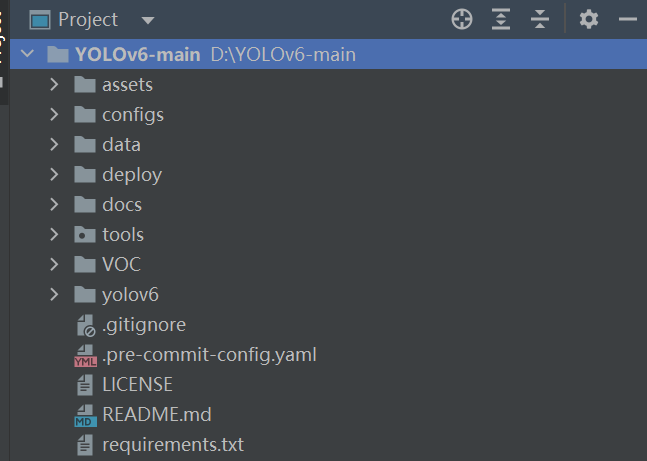
打开requirements.txt,查看本地环境缺少哪些库,然后安装即可。
torch>=1.8.0
torchvision>=0.9.0
numpy>=1.18.5
opencv-python>=4.1.2
PyYAML>=5.3.1
scipy>=1.4.1
tqdm>=4.41.0
addict>=2.4.0
tensorboard>=2.7.0
pycocotools>=2.0
onnx>=1.10.0 # ONNX export
onnx-simplifier>=0.3.6 # ONNX simplifier
thop # FLOPs computation
在tools文件夹下面新建__init__.py,里面不放任何内容。
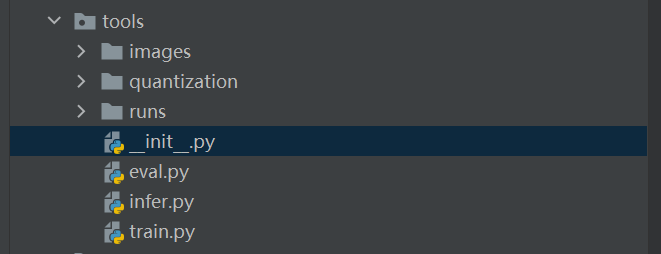
因为在其他地方引用了tools里面的文件,不加这个脚本就会报错。
修改yaml文件
打开data/dataset.yaml,如下图:

# Please insure that your custom_dataset are put in same parent dir with YOLOv6_DIR
train: ../VOC/images/train # train images
val: ../VOC/images/val # val images
test: ../VOC/images/test # test images (optional)
# whether it is coco dataset, only coco dataset should be set to True.
is_coco: False
# Classes
nc: 2 # number of classes
names: ['aircraft', 'oiltank'] # class names
train、val、test:代表image路径。
如果我们使用命令python tools/train.py训练,则将目录设置为:
train: ./VOC/images/train # train images
val: ./VOC/images/val # val images
test: ./VOC/images/test # test images (optional)
如果在tools目录下使用python train.py或者直接run,则将目录设置为:
train: ../VOC/images/train # train images
val: ../VOC/images/val # val images
test: ../VOC/images/test # test images (optional)
这个细节要注意一下,启动的目录不同,对应的路径也不相同。
修改train.py
def get_args_parser(add_help=True):
parser = argparse.ArgumentParser(description='YOLOv6 PyTorch Training', add_help=add_help)
parser.add_argument('--data-path', default='../data/dataset.yaml', type=str, help='path of dataset')
parser.add_argument('--conf-file', default='../configs/yolov6s.py', type=str, help='experiments description file')
parser.add_argument('--img-size', default=640, type=int, help='train, val image size (pixels)')
parser.add_argument('--batch-size', default=16, type=int, help='total batch size for all GPUs')
parser.add_argument('--epochs', default=400, type=int, help='number of total epochs to run')
parser.add_argument('--workers', default=0, type=int, help='number of data loading workers (default: 8)')
parser.add_argument('--device', default='0', type=str, help='cuda device, i.e. 0 or 0,1,2,3 or cpu')
parser.add_argument('--eval-interval', default=20, type=int, help='evaluate at every interval epochs')
parser.add_argument('--eval-final-only', action='store_true', help='only evaluate at the final epoch')
parser.add_argument('--heavy-eval-range', default=50, type=int,
help='evaluating every epoch for last such epochs (can be jointly used with --eval-interval)')
data-path:数据集配置文件的路径。
conf-file:模型配置文件的路径。
img-size:输入图片的尺寸,将图片resize该尺寸输入到模型中。yolo系列的模型一般要求尺寸为32的倍数。
batch-size:BatchSize的大小。根据显卡的显存设置,一般情况拉满显存即可。
epochs:epoch的大小。
workers:cpu核数的设置,在win系统设置为0。
workers:验证的间隔。
然后就可以开始训练,我这里直接运行train.py脚本。
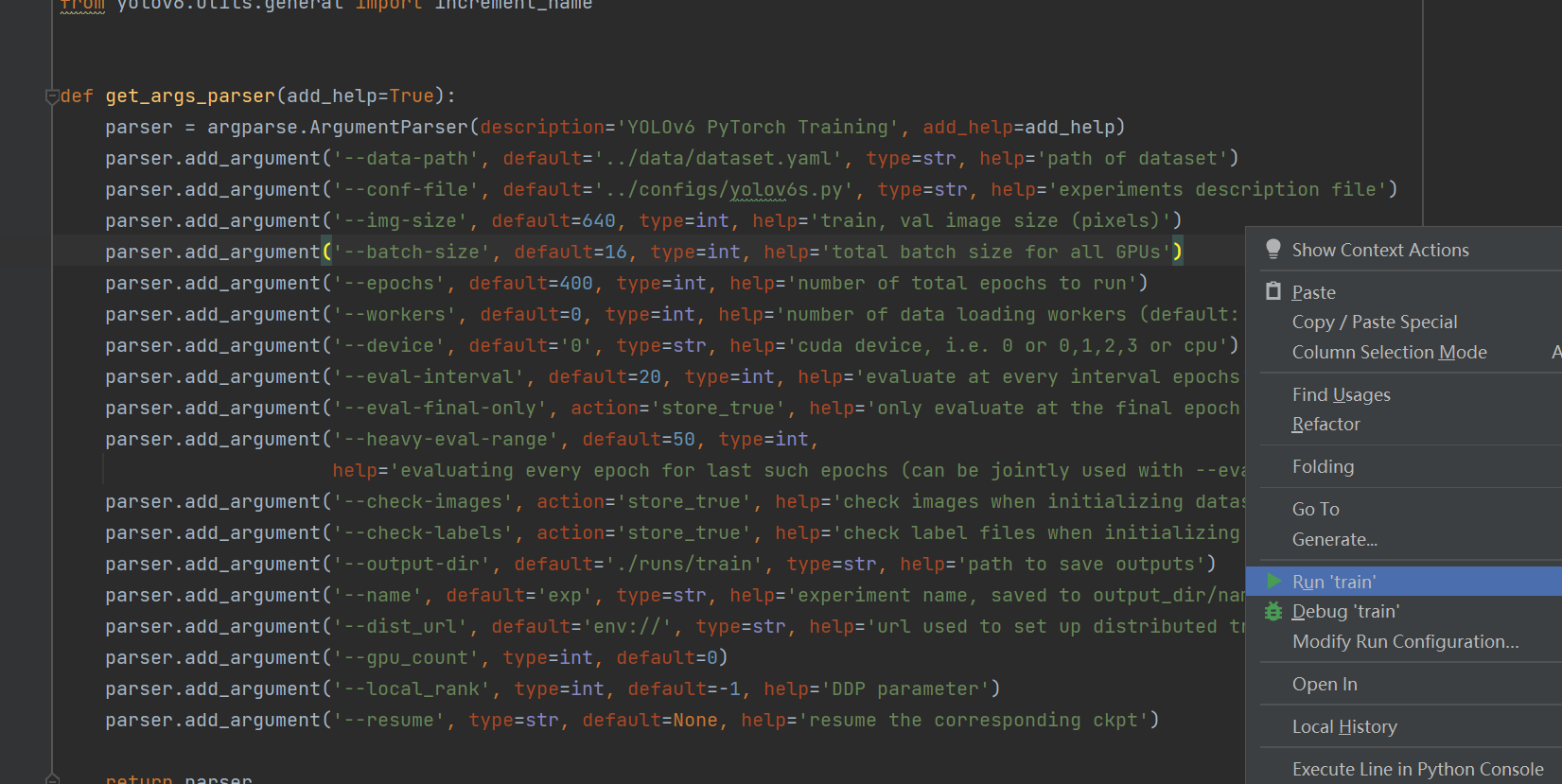
由于数据集量不大,很快就能跑完。

测试
等训练完成后就可以开启测试了。训练完成后我们在tools/runs找到weights,选用best_ckpt.pt。
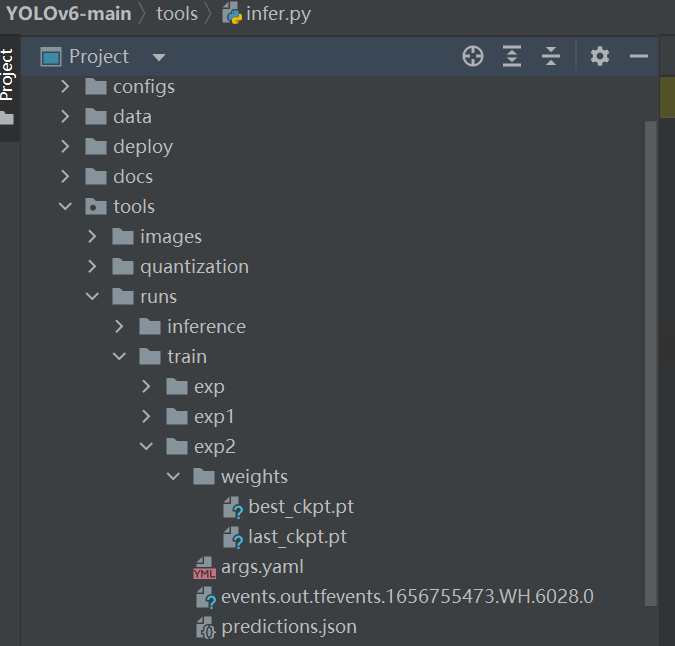
打开tools/infer.py,修改参数:
def get_args_parser(add_help=True):
parser = argparse.ArgumentParser(description='YOLOv6 PyTorch Inference.', add_help=add_help)
parser.add_argument('--weights', type=str, default='runs/train/exp2/weights/best_ckpt.pt', help='model path(s) for inference.')
parser.add_argument('--source', type=str, default='images', help='the source path, e.g. image-file/dir.')
parser.add_argument('--yaml', type=str, default='../data/dataset.yaml', help='data yaml file.')
parser.add_argument('--img-size', type=int, default=640, help='the image-size(h,w) in inference size.')
parser.add_argument('--conf-thres', type=float, default=0.25, help='confidence threshold for inference.')
parser.add_argument('--iou-thres', type=float, default=0.45, help='NMS IoU threshold for inference.')
parser.add_argument('--max-det', type=int, default=1000, help='maximal
weights:训练权重的路径。
source:测试图片的路径,我这里把测试图片放在tools/images文件夹下面。
img-size:和训练的图片保持一致。
conf-thres:置信度的最小值。
iou-thres:IoU的值。
max-det:单张图片检测到目标不能超过该值。
运行inter.py测试images中的图片。
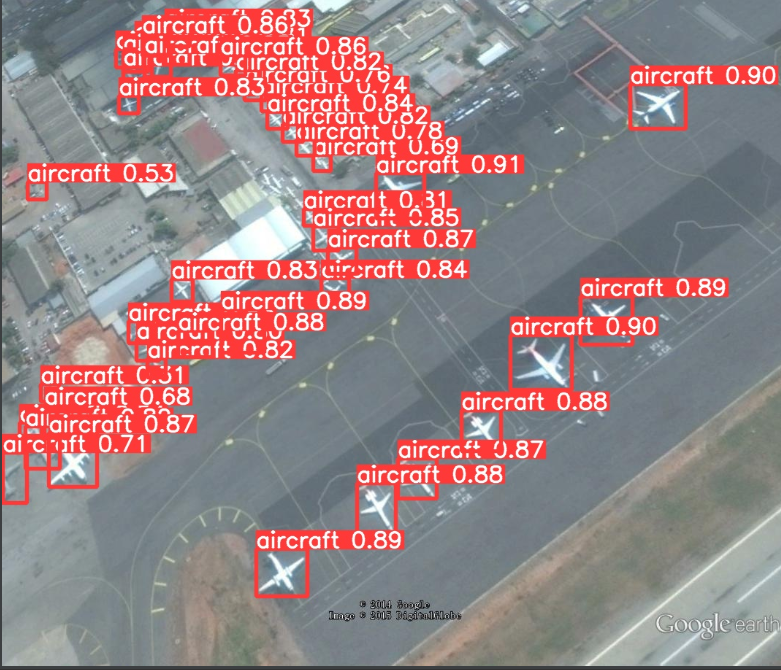
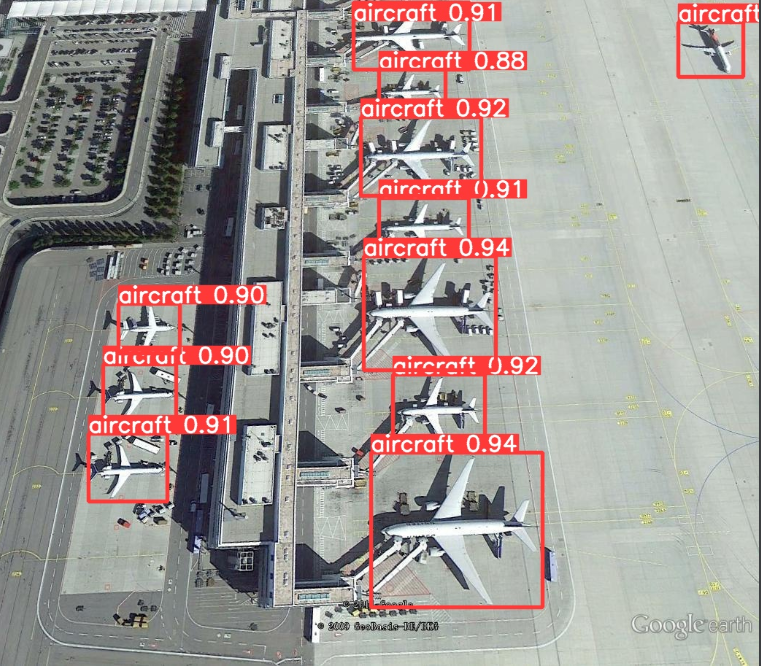
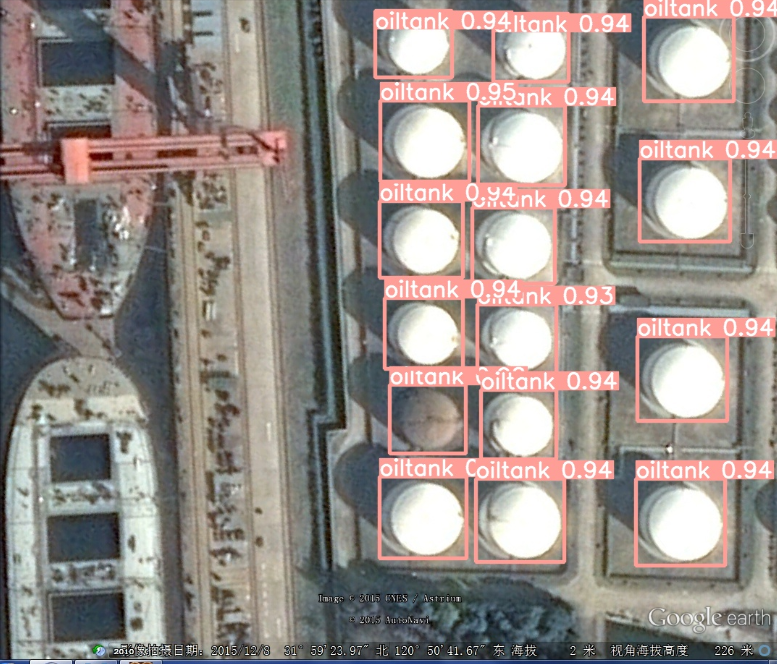
效果确实不错!!!
完整的代码
https://download.csdn.net/download/hhhhhhhhhhwwwwwwwwww/85881120?spm=1001.2014.3001.5503
- 点赞
- 收藏
- 关注作者



评论(0)